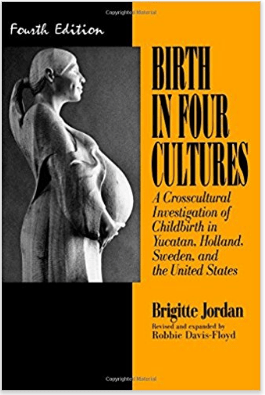Birth In Four Cultures Book Review
Guest blog post by Destiny Olsen.
As a world traveler, birth and postpartum doula, and woman who has lived in various countries, I was ecstatic for the chance to review the book, Birth in Four Cultures written by Brigitte Jordan, an anthropologist, then later expanded and revised by Robbie Davis-Floyd. This piece is a cross-cultural study of how women bear children, and is a reminder of the complex layers that make up a community of people and how they dynamically apply their approach to the childbearing year.
The book is split into two parts: Childbirth in Biosocial, Cross-Cultural Perspective and Authoritative Knowledge in Childbirth. Each part plays an important role in understanding the birth systems in the Yucatan, the United States, Sweden and Holland. Under a microscopic view from Jordan and associates, they paint a thorough description of each of the four social-medical traditions around birth, and although each varies drastically from the rest, the comparison that Jordan draws is highly complex due to the cultural differences that shape each community.
Often times we as birth workers, expectant parents, and community members look at our current techno-medically driven system here in the United States with high regard. At the same time, some circles desire a less techno-medically driven approach. In a country with high infancy and mother mortality rates, we want the healthiest practices and best outcome for our clients and loved ones. How do Americans compare to alternative childbirth systems that are successful, when culturally we aren’t the same? What is missing from our current American structure? How can the American culture start to achieve better birth experiences and outcomes? How has the child-birthing system in United States changed over time? Lastly, how can we as Americans encourage this system to evolve, when we are on the inside looking out?
In a country with high infancy and mother mortality rates, we want the healthiest practices and best outcome for our clients and loved ones. How do Americans compare to alternative childbirth systems that are successful, when culturally we aren’t the same?
As Jordan puts it, “As a life crisis event, birth is everywhere, a consensual shaping and social regulation–the particular pattern depending on local history, ecology, social structure, technological development, and the like.” Simply put, it’s not that easy to change a system that has developed throughout medical, social and political histories, thus creating socio-medical norms. In each of the communities Jordan analyzed, she discovered that populations accept varying experiences of how we birth. Consequently, when implementing change, we need to “appreciate the systemic structure of childbirth practices to then rationalize how procedures are justified to begin with.”
Also, where we in the United States are more technologically developed than others, we tend to be viewed as more “advanced.” With our technological advances we are held as an example to teach those more “primitive” than our own. When we have other cultures looking to us as an example to work toward, why should we feel the need to change? Are we relying too much on our technological systems, rather than listening to our childbearing mothers? Due to technology, we disregard the biological cues that occur, then placing our mothers in a compromised condition. Could this be the reason our mothers and children are falling short of a better outcome?
Due to technology, we disregard the biological cues that occur, then placing our mothers in a compromised condition. Could this be the reason our mothers and children are falling short of a better outcome?
Jordan’s book offers an informative, well-rounded display of the current birthing systems, their strengths, short comings, and what this means for the evolution of birthing practices around the world. While reading this book, I was reminded of all the magical places I have lived and explored, the people I have met, the new traditions I have embraced, partially making me who I am today.
As I continue through my doula journey, it is critical to understand the social, spiritual, and medical reasons behind specific birthing practices, and to respect the authentic cultures in which these practices developed. Often times, because our cultures differ so greatly, I’ve seen when implementing foreign birthing practices in the US, the practices become distorted and void of their original intent. This conundrum occurs in similar ways when advanced medical technologies from the US are transferred to adolescent countries that lack the resources and technological infrastructure to support them. At a time when cultural appropriation is circulating frequently in conversation- I implore all those reading to dive deeper in a critical examination of the successful, customary practices being carried out in America today and honor the origin of these traditions and it’s peoples.




This is truly helpful, thanks.